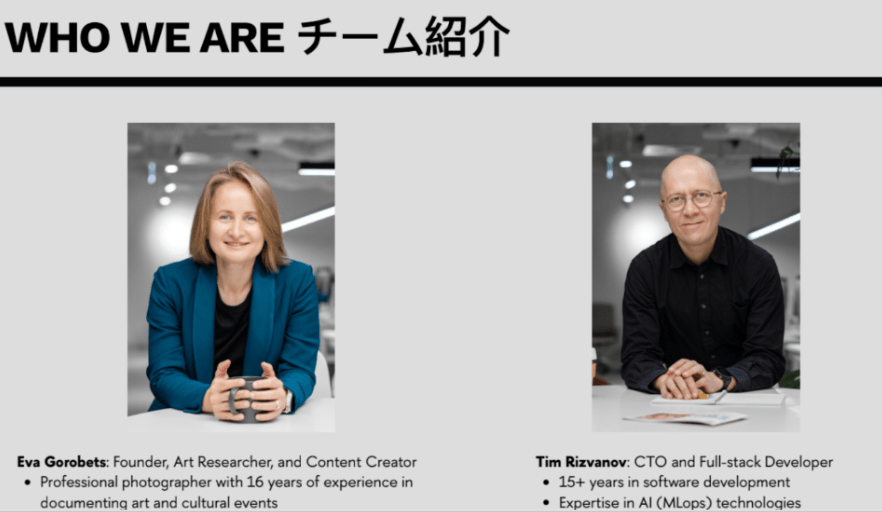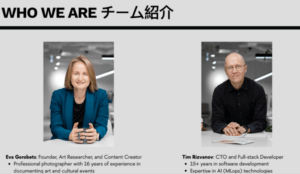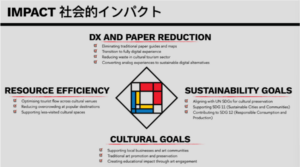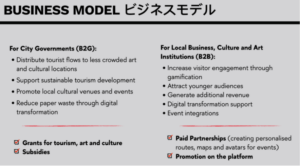News

Interview with Tim & Eva (English version below)
90Daysプログラム 参加者インタビュー(Tim & Eva)
インタビュアー(SPEAKER 02): 今日はインタビューにご協力いただきありがとうございます。まず簡単に自己紹介をお願いします。
Tim(SPEAKER 00): こんにちは、Tim Rizvanovです。オーストラリア・メルボルン出身のアートキュレーターで、「Art Flunner」というプロジェクトを運営しています。私たちは、メルボルンのギャラリーや展覧会の情報を一元化するためのプラットフォームを立ち上げました。
Eva(SPEAKER 01): Eva Gorobetsです。カザフスタン・アスタナ出身で、プロの写真家として16年間活動しています。文化研究の修士号を取得し、現在は美術・応用芸術分野の博士課程に在籍中です。アートマネジメントの経験もあり、限定版アートの制作・販売を行うエージェンシーを運営していました。

インタビュアー: 現在のビジネスについて詳しく教えてください。
Tim: 私たちは、京都府の地域アートやクラフト、アート関連ビジネスを支援するプロジェクトを展開しています。特に、京都市外の地域に焦点を当てています。京都市内は観光客が特定のエリアに集中するため、私たちは人の流れを分散させ、地域全体に恩恵をもたらす仕組みを作りたいと考えています。
また、既存のアプリ「Art Flaneur」を発展させ、ゲーム要素を取り入れる予定です。例えば、地域ごとの伝説や神話をもとに「精霊」や「守護者」といったキャラクターを作成し、ユーザーがクイズやチャレンジを通じてその土地について学べる仕組みを導入します。
Eva: 課題として、観光案内の紙の地図やパンフレットの使用が環境負荷を生んでいます。私たちは、それらをデジタル化し、より持続可能な観光情報提供の方法を模索しています。

インタビュアー: このアイデアはどのようにして生まれたのですか?
Eva: もともとはメルボルンで、アートイベントや展覧会の情報が一カ所にまとまっていないことに気づいたのがきっかけでした。そこで、最初は私たち自身のために情報を集約するアプリを作成しました。しかし、より多くの人に役立つ可能性があると気づき、エンターテインメント要素を加えて発展させることにしました。
Tim: ゲーミフィケーションのアイデアは当初からありましたが、技術的なハードルがありました。しかし、最近になってAIや3D技術の発展により、実現可能になったと感じています。
インタビュアー: 実際に京都に滞在してみて、どんな印象を受けましたか?
Tim: 京都はコンパクトで整然としており、とても魅力的な街です。大阪にも行きましたが、京都はより落ち着いた雰囲気があります。
Eva: 特に印象的だったのは、京都の郊外にある文化や伝統的な場所です。例えば、福知山の大江山地域では、和紙の生産や地元の神話に基づいたアートに出会いました。これらを私たちのプロジェクトに取り入れたいと考えています。
インタビュアー: 現在直面している課題は何ですか?
Tim: 最大の課題は資金調達です。一般的なVC(ベンチャーキャピタル)は短期間での利益を求める傾向がありますが、私たちのプロジェクトは長期的な取り組みです。そのため、インパクト投資や複数の資金源を組み合わせる方法を模索しています。
Eva: もう一つの課題は言語の壁です。特にネットワーキングイベントでは、日本語を話せる人が少ないと情報収集が難しくなります。そのため、日本語の学習にも力を入れています。
インタビュアー: 今後の目標を教えてください。
Eva: 第一に、スタートアップビザを取得し日本でのチームを構築することです。開発者、アーティスト、3Dモデラーなどを集め、プロジェクトを強化したいと考えています。
Tim: また、地元の協力者やパートナーを増やし、具体的なパイロットプロジェクトを実施することが重要です。最初の実験的な取り組みとして、福知山での展開を計画しています。

インタビュアー: 本日は貴重なお話をありがとうございました!
90Days Program Participant Interview (Tim & Eva)
Interviewer: Thank you for taking the time to do this interview today. First of all, please briefly introduce yourself.
Tim: Hi, I’m Tim Rizvanov. I’m an art curator from Melbourne, Australia, and I run a project called Art Flunner. We’ve launched a platform to centralise information on Melbourne’s galleries and exhibitions.
Eva: I’m Eva Gorobets. Originally from Astana, Kazakhstan, I have been working as a professional photographer for 16 years. I hold a Master’s degree in Cultural Studies and am currently enrolled in a doctoral program in the field of fine and applied arts. I also have a background in art management and ran an agency that produced and sold limited edition art.

Interviewer: Can you tell us more about your current business?
Tim: We are developing a project to support local arts and crafts and art-related businesses in Kyoto Prefecture. In particular, we focus on areas outside Kyoto city. Since tourists are concentrated in a specific area in Kyoto, we want to create a system that decentralizes the flow of people and benefits the entire region.
We also plan to expand on the existing Art Flaneur app and incorporate game elements. For example, we will create characters such as “spirits” and “guardians” based on local legends and myths, and introduce a mechanism that allows users to learn about the area through quizzes and challenges.
Eva: Another challenge is that the use of paper maps and brochures for tourist information has an environmental impact. We are looking for ways to digitize them and provide more sustainable tourism information.

Interviewer: How did this idea come about?
Eva: It all started in Melbourne when I noticed that there wasn’t a lot of information about art events and exhibitions in one place. So, at first, we created an app that aggregated information for ourselves. However, we realized that it could be useful to more people, so we decided to develop it with an entertainment element.
Tim: The idea of gamification was there from the beginning, but there were technical hurdles. However, I feel that it has become feasible with the recent development of AI and 3D technology.
Interviewer: What kind of impressions did you get when you stayed in Kyoto?
Tim: Kyoto is a very attractive city because it is compact and organized. I’ve also been to Osaka, but Kyoto has a more relaxed atmosphere.
Eva: I was particularly impressed by the cultural and traditional places on the outskirts of Kyoto. For example, in the Fukuchiyama areas, I encountered art based on the production of Japanese paper and local mythology. We would like to incorporate these into our projects.
Interviewer: What are the challenges you are currently facing?
Tim: The biggest challenge is fundraising. While VCs (venture capitalists) in general tend to seek short-term profits, our project is a long-term effort. That’s why we’re looking for ways to combine impact investing and multiple sources of funding.
Eva: Another challenge is the language barrier. Especially at networking events, it becomes difficult to gather information if there are few people who can speak Japanese. Therefore, we also put a lot of effort into learning Japanese.
Interviewer: What are your goals for the future?
Eva: First, obtaining a startup visa and build team in Japan. We want to bring together developers, artists, 3D modelers, and more to enhance our projects.
Tim: It’s also important to increase local collaborators and partners and implement specific pilot projects. As a first experimental initiative, we are planning to expand to Fukuchiyama and move onto other regions gradually.

Interviewer: Thank you very much for your time today!


